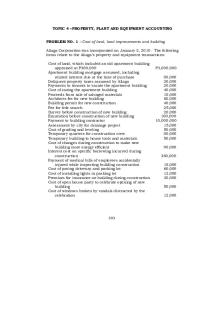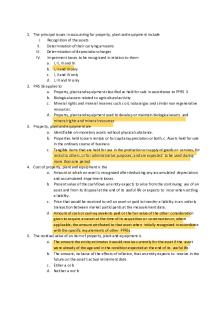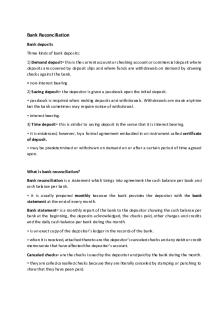Intermediate Accounting Test Bank on PPE PDF

| Title | Intermediate Accounting Test Bank on PPE |
|---|---|
| Author | Jan Kimberly Virtudazo |
| Course | Bachelor of Science in Accountancy |
| Institution | Polytechnic University of the Philippines |
| Pages | 5 |
| File Size | 116.3 KB |
| File Type | |
| Total Downloads | 114 |
| Total Views | 300 |
Summary
The principal issues in accounting for property, plant and equipment include I. Recognition of the assets II. Determination of their carrying amounts III. Determination of depreciation charges IV. Impairment losses to be recognized in relation to them a. I, II, III and IV b. I, II and III only c. I,...
Description
1. The principal issues in accounting for property, plant and equipment include I. Recognition of the assets II. Determination of their carrying amounts III. Determination of depreciation charges IV. Impairment losses to be recognized in relation to them a. I, II, III and IV b. I, II and III only c. I, II and IV only d. I, III and IV only 2. PAS 16 applies to a. Property, plant and equipment classified as held for sale in accordance to PFRS 5 b. Biological assets related to agricultural activity c. Mineral rights and mineral reserves such s oil, natural gas and similar non regenerative resources. d. Property, plant and equipment used to develop or maintain biological assets and mineral rights and mineral resources 3. Property, plant and equipment are a. Identifiable on-monetary assets without physical substance. b. Properties held to earn rentals or for capital appreciation or both. c. Assets held for sale in the ordinary course of business c. Tangible items that are held for use in the production or supply of goods or services, for rental to others, or for administrative purposes; and are expected to be used during more than one period. 4. Cost of property, plant and equipment is the a. Amount at which an asset is recognized after deducting any accumulated depreciation and accumulated impairment losses. b. Present value of the cash flows an entity expects to arise from the continuing use of an asset and from its disposal at the end of its useful life or expects to incur when settling a liability. c. Price that would be received to sell an asset or paid to transfer a liability in an orderly transaction between market participants at the measurement date. d. Amount of cash or cash equivalents paid or the fair value of the other consideration given to acquire an asset at the time of its acquisition or construction or, where applicable, the amount attributed to that asset when initially recognized in accordance with the specific requirements of other PFRSs. 5. The residual value of an item of property, plant and equipment is a. The amount the entity estimates it would receive currently for the asset if the asset were already of the age and in the condition expected at the end of its useful life. b. The amount, inclusive of the effects of inflation, that an entity expects to receive in the future on the asset’s actual retirement date. c. Either a or b d. Neither a nor b
6. Useful life of property, plant and equipment is: a. The period over which an asset is expected to be available for use by an entity. b. The number of production or similar units expected to be obtained from the asset by an entity. c. Either a or b d. Neither a nor b 7. Which statement is incorrect regarding spare parts and servicing equipment? a. Spare parts and servicing equipment are usually carried as inventory and recognized in profit or loss as consumed. b. Major spare parts and stand-by equipment qualify as property, plant and equipment when an entity expects to use them during more than one period. c. Spare parts and servicing equipment that can be used only in connection with an item of property, plant and equipment are accounted for as property, plant and equipment d. None of the above 8. Items of property, plant and equipment acquired for safety or environmental reasons a. Qualify as assets because the acquisition of such property, plant and equipment directly increases the future economic benefits of existing item of property, plant and equipment. b. Qualify as assets because they enable an entity to derive future economic benefits from related assets in excess of what could be derived had those items not been acquired. c. Do not qualify as assets because the acquisition of such property, plant and equipment does not directly increase the future economic benefits of existing item of property, plant and equipment. d. Do not qualify as assets because the acquisition of such property, plant and equipment is not necessary for an entity to obtain the future economic benefits from its other assets. 9. A condition of continuing to operate an item of property, plant and equipment (for example, an aircraft) may be performing regular major inspections for faults regardless of whether parts of the items are replaced. When each major inspection is performed, its cost is a. Recognized in profit or loss as incurred b. Often described as for the repairs and maintenance of the item of property, plant and equipment c. Recognized in other comprehensive income as incurred d. Recognized in the carrying amount of the item of property, plant and equipment as a replacement if the recognition criteria are satisfied. 10. An item of property, plant and equipment that qualifies for recognition as an asset shall be measured at a. The amount of cash or cash equivalents paid. b. The fair value of the other consideration given to acquire an asset at the time of its acquisition or construction c. The amount attributed to that asset when initially recognized in accordance with the specific requirements f other PFRSs.
d. Any of the above. 11. The cost of an item of property, plant and equipment comprises: I. Its purchase price, including import duties and non-refundable purchase taxes, after deducting trade discounts and rebates. II. Any costs directly attributable to bringing the asset to the location and condition necessary for it to be capable of operating in the manner intended by management. III. The initial estimate of the costs of dismantling and removing the item and restoring the site on which it is located, the obligation for which an entity incurs either when the item is acquired or as a consequence of having used the item during a particular period for purposes other than to produce inventories during that period. a. I, II and III b. I and II only c. I and III only d. I only 12. Costs directly attributable to bringing the asset t the location and condition necessary for it to be capable of operating in the manner intended by management exclude a. Costs of employee benefits arising directly from the construction or acquisition of the time of property, plant and equipment b. Costs of site preparation c. Initial delivery and handling costs d. Administration and other general overhead costs. 13. Costs directly attributable to bringing the asset t the location and condition necessary for it to be capable of operating in the manner intended by management exclude a. Installation and assembly costs b. Costs of testing whether the asset is functioning properly c. Professional fees d. Costs of opening new facility 14. Examples of costs that are not of an item of property, plant and equipment exclude: a. Costs of introducing a new product or service b. Costs of advertising and promotional activities c. Costs of conducting business in a new location or with a new class of customer. d. Professional fees. 15. The following costs are not included in the carrying amount of an item of property, plant and equipment, except a. Costs incurred while an item capable of operating in the manner intended by management has yet to be brought into use or is operated at less than full capacity. b. Initial operating losses, such as those incurred while demand for the item’s output builds up. c. Costs of relocating or reorganizing part or all of an entity’s operations. d. None of the above
16. The cost of an item of property, plant and equipment includes the costs of its dismantlement, removal or restoration, the obligation for which an entity incurs as a consequence of IGA CPA REVIEW a. Installing the item b. Using the item during a particular period for the purposes other than to produce inventories during that period. c. Both a and b d. Neither a nor b 17. Income earned through using a building site as a car park until construction starts is a. Recognized in profit or loss b. Deducted from the cost of building c. Deducted from the cost of land d. Deducted form he cost of land and building pro rata 18. The cost of a self-constructed asset may include a. Internal profits b. Cost of abnormal amounts of wasted material, labor, or other resources. c. Borrowing costs d. All of the above. 19. The cost of an item of property, plant and equipment is the cash price equivalent at the recognition date. If payment is deferred beyond normal credit terms, the difference between the cash price equivalent and the total payment is recognized as a. Interest over the period of credit unless such interest is capitalized in accordance with PAS 23 b. Part of the carrying amount of the asset c. Either as interest over the period of credit or as part of the carrying amount of the asset depending on the entities accounting policy d. Interest at the recognition date. 20. An entity is required to measure an item of property, plant and equipment acquired in exchange for a non-monetary asset or assets, r a combination of monetary and non-monetary assets, at fair value unless a. The exchange transaction lacks commercial substance b. The exchanged assets are similar c. Both a and b d. Neither a nor b 21. If the fair value of neither the asset received nor the asset given up is reliably measurable, the acquired item is measured at a. The carrying amount of the asset given up b. The carrying amount of the asset received c. Either a or b d. Neither a nor b 22. The fair value of an asset is reliably measurable if
23.
24.
25.
26.
a. The variability in the range of reasonable fair value measurements is not significant for that asset. b. The probabilities of the various estimates within the range can be reasonably assessed and used when measuring fair value. c. Either a or b d. Neither a nor b Which statement is incorrect regarding acquisition of property, plant and equipment in exchange for a non-monetary asset, or a combination of monetary and non-monetary asset? a. An entity determines whether an exchange transaction has commercial substance by considering the extent to which its future cash flows are expected to change as a result of the transaction. b. For the purpose of determining whether an exchange transaction has commercial substance, the entity-specific value of the portion of the entity’s operations affected by the transaction shall reflect pre-tax cash flows. c. The cost of such an item of property, plant and equipment is measured at fair value. d. If the acquired item is not measured at fair value, its cost is measured at the carrying amount of the asset given up. An entity acquired a piece of land with existing building with the intention to demolish the old building right away in order to construct a new building on its site as part of its planned redevelopment. In accordance with PIC Q&A No. 2012- 02, it is appropriate for the entity to account for the carrying value of the old building as part of the cost of the new building a. That will be used as an owner-occupied property. b. That will be held as an investment property. c. That will be sold as an inventory. d. None of the above. An entity acquired a piece of land with existing building with the intention to initially use the old building as an owner-occupied property and then demolish it in a future period and replace it with a new building. In accordance with PIC Q&A No. 2012-02, it is appropriate for the entity to account for the carrying value of the old building as part of the cost of the new building a. That will be used as an owner-occupied property. b. That will be held as an investment property. c. That will be sold as an inventory. d. None of the above. In accordance with PIC Q&A No. 2012-02, the costs incurred in relation to demolition (or the physical tearing down) of the old building to give way for the construction of the replacement building should preferably be a. Expensed b. Capitalized as part of the cost of land. c. Capitalized as land improvements. d. Capitalized as part of the cost of the new building....
Similar Free PDFs

Intermediate Accounting PPE REVALS
- 24 Pages

PPE - intermediate accounting 1
- 7 Pages

INTERMEDIATE ACCOUNTING TEST Banks
- 44 Pages

TEST BANK -Financial Accounting
- 15 Pages

Government Accounting test bank
- 22 Pages

Practical Accounting Problems - PPE
- 66 Pages
Popular Institutions
- Tinajero National High School - Annex
- Politeknik Caltex Riau
- Yokohama City University
- SGT University
- University of Al-Qadisiyah
- Divine Word College of Vigan
- Techniek College Rotterdam
- Universidade de Santiago
- Universiti Teknologi MARA Cawangan Johor Kampus Pasir Gudang
- Poltekkes Kemenkes Yogyakarta
- Baguio City National High School
- Colegio san marcos
- preparatoria uno
- Centro de Bachillerato Tecnológico Industrial y de Servicios No. 107
- Dalian Maritime University
- Quang Trung Secondary School
- Colegio Tecnológico en Informática
- Corporación Regional de Educación Superior
- Grupo CEDVA
- Dar Al Uloom University
- Centro de Estudios Preuniversitarios de la Universidad Nacional de Ingeniería
- 上智大学
- Aakash International School, Nuna Majara
- San Felipe Neri Catholic School
- Kang Chiao International School - New Taipei City
- Misamis Occidental National High School
- Institución Educativa Escuela Normal Juan Ladrilleros
- Kolehiyo ng Pantukan
- Batanes State College
- Instituto Continental
- Sekolah Menengah Kejuruan Kesehatan Kaltara (Tarakan)
- Colegio de La Inmaculada Concepcion - Cebu









